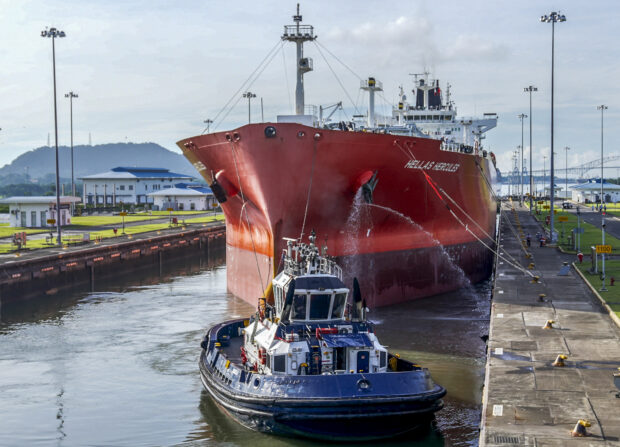Panama plans dry alternative to drought-hit canal

A cargo ship navigates through the Panama Canal in the area of the Cocoli Locks, in Panama City on Agust 25, 2023. Panama launched on April 10, 2024 the project of a “Multimodal Dry Canal” to move cargo between the Pacific and Atlantic oceans, given the lack of water that forced it to reduce the crossing of ships through its century-old maritime channel. (Photo by Ivan PISARENKO / AFP)
PANAMA CITY — Panama on Wednesday unveiled plans for a “dry canal” to move cargo between the Pacific and Atlantic oceans due to low water levels in its century-old maritime channel.
The Panama Canal usually handles about six percent of global maritime trade, but a drought caused by climate change and the El Niño phenomenon has forced authorities to limit the number of ships passing through.
The Multimodal Dry Canal project will use existing roads, railways, port facilities, airports, and duty-free zones in a new “special customs jurisdiction,” said Rodolfo Samuda, director of logistics at the Ministry of the Presidency.
It will not require any investment thanks to its use of existing infrastructure, he said at the presentation of the project.
A decree simplifying procedures for transporting cargo by land across the isthmus has already been declared by President Laurentino Cortizo.
The project aims “to complement the Panama Canal” and resolve the problems facing its users, said Guillermo Salazar, director of the country’s state development planning institute.
READ: Drought-hit Panama Canal to restrict access for one year
Now 27 ships navigate the Panama Canal daily, compared with 39 previously.
Capacity restrictions
Unlike the Suez Canal, it uses fresh water provided by previously abundant tropical rains stored in two artificial lakes, which are also a crucial source of drinking water.
The canal — used mainly by customers from the United States, China, Japan and South Korea — has a system of locks to raise and lower ships.
For each vessel that passes through it, 200 million liters of fresh water are released into the sea.
READ: UN alarmed by global trade disruption
The capacity restrictions have caused a marine traffic jam on some days of more than 100 ships waiting to enter the 50-mile (80-kilometer) waterway, which was inaugurated in 1914.
To avoid a delay, some vessels paid up to four million dollars for a slot in an auction, in addition to the usual toll.
The problems are seen as potential economic opportunity by some of Panama’s neighbors.
In December, Mexico unveiled an interoceanic railway billed as an alternative to the canal.
Honduras presented an ambitious project for a freight railroad between the Pacific and the Atlantic in February, although it currently lacks the financing to build it.